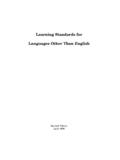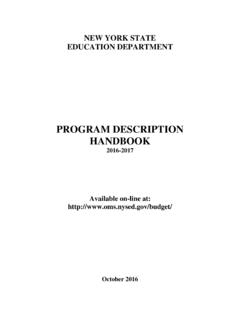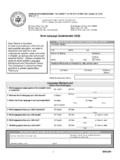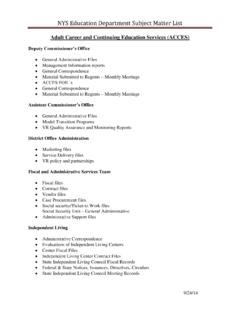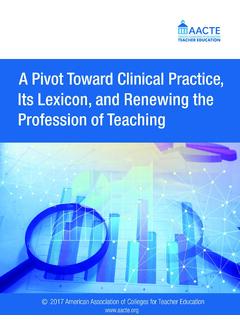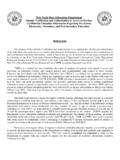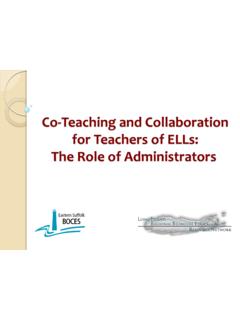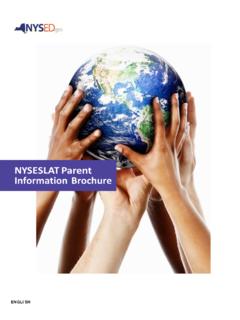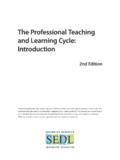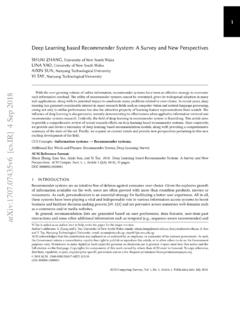Transcription of New York State Next Generation English Language Arts Early ...
1 NEW YORK State . EDUCATION DEPARTMENT. New York State Next Generation Standards Early learning introduction 1. NEW YORK State . EDUCATION DEPARTMENT. introduction to the New York State Next Generation Early learning Standards Written by Dr. Zoila Morell, Mercy College The task of revising the Early learning Standards provided an opportunity to articulate a shared understanding of what young children can achieve with our support. Across New York State , educators, community members, researchers, and policymakers all advocated for what would be best for all children developmentally appropriate expectations within a context that embraces children's multiple identities and differing abilities.
2 Standards represent a belief that equitable outcomes among diverse populations are possible when we focus our instruction and programming on who children are and what they need. Standards are only ideals, however, without the investment and dedication of the educators and parents, family members, and other adults in children's lives. It is their work and protective care that empowers children to reach their fullest potential and makes real the Standards' potential to equalize academic achievement for New York's young children. Articulating the New York State Standards for the youngest children in prekindergarten to third grade required particular attention to the nature of learning in Early childhood.
3 The members of the Early learning Task Force, along with the hundreds of educators, Early childhood professionals, and community members who provided feedback during the period of public comment advocated strongly for a clear articulation to key questions: Given the range in child development, is it appropriate to set Standards for young children? How can Standards protect developmentally appropriate expectations and practices? How can we support children with special learning needs? Are the same Standards applicable for diverse population groups among children? How can we support children who do not speak English ?
4 As these key questions emerged repeatedly, the Early learning Task Force recognized the need to begin by distinguishing between standards for learning and standardization of instruction. New York State Education Department introduction TO THE NYS NEXT Generation Early learning STANDARDS. Page 2 of 7. NEW YORK State . EDUCATION DEPARTMENT. Standards for learning , not Standardization of Instruction The New York Early learning Standards represent outcomes by grade level in an overall framework of a lifelong development of skills, dispositions and habits with regards to learning . Envisioning the practices of literate adults, we recognize how these practices are necessarily developed and nurtured over a lifetime, beginning in Early childhood.
5 For example, long before children are reading conventionally, there is a continuum of emergent skills that are stimulated and reinforced as Early as infancy. This occurs through reading or telling stories and exposing babies to books. 1 The Standards, then, serve to describe points along a continuum towards lifelong development. In this continuum, we hold the same aspirations and goals for everyone; the outcomes described in the Standards are meant for all children, regardless of their circumstances. Standards do not solely define what the well-prepared or precocious child can achieve, but what can be achieved by all children through personalized instruction.
6 Rather than prescribe a lockstep progression of lessons or curricula for all children in all settings, the Standards serve to articulate the expectations of what children can learn and do as a result of instruction that is not standardized, but personalized, differentiated, adapted, culturally and linguistically relevant, and context-based. While we may have the same learning objectives for all children, our means for meeting these objectives are highly responsive to the individual child. Setting Standards for Young Children The joint position statement of the National Association for the Education of Young Children (NAEYC) and the National Association of Early Childhood Specialists in State Departments of Education (NAECS/SDE) states: By defining the desired content and outcomes of young children's education, Early learning Standards can lead to greater opportunities for positive development and learning in these Early years.
7 2 This is possible within a context of developmentally appropriate expectations and practices where the responsibility to meet Standards is not a burden placed on the child, but a professional framework for their educators. 1 Teale, , Sulzby, E. (1992). Emergent literacy: Writing and reading. Norwood, New Jersey: Ablex Publishing Corporation; Fields, M., Groth, L., Spangler, K. (2004). Let's begin reading right: A developmental approach to emergent literacy, 5th Ed. Upper Saddle River, NJ, Columbus, OH: Pearson Merill Prentice-Hall 2 NAEYC & NAECS/SDE. (2002). Early learning Standards: Creating the Conditions for Success.
8 Washington DC: Author. New York State Education Department introduction TO THE NYS NEXT Generation Early learning STANDARDS. Page 3 of 7. NEW YORK State . EDUCATION DEPARTMENT. There is considerable variability in development among children that mirrors the nature and quality of their Early experiences. 3 Responsive to this variability, Standards are not intended as a rationale to either accelerate or postpone instruction; instead, they define the outcome for children to reach or move towards at their own pace. 4. Protecting Developmentally Appropriate Expectations and Practices NAEYC defines developmentally appropriate practices (DAP) as a framework of principles that promote children's learning and development.
9 5 In summary, these principles highlight the need for educators to: Demonstrate knowledge of child development and age-related characteristics;. Understand the interrelated nature of developmental domains where learning in one area will influence another;. Recognize how prior experiences as well cultural and social factors shape children's behavior and approaches to learning ;. Develop strong, loving relationships with children and their families that enable personalizing instruction;. Create opportunities for children to develop positive relationships with their peers;. Design age appropriate experiences that both stimulate and gratify children's natural curiosity and desire to understand their world; and Understand the importance of play in promoting learning .
10 Grounded in these same principles, the Standards seek to protect developmentally appropriate expectations and practices for all children prekindergarten to third grade, even as the curricula or instructional programs that support these principles are locally determined choices. Students with Disabilities (SWD), like their typically developing peers, rely on developmentally appropriate practices to meet Standards. The Council of Exceptional Children lists one of its foundational imperatives for educators as, Maintaining challenging expectations for individuals with exceptionalities to develop the highest possible learning outcomes and quality of life potential in ways that respect their dignity, culture, Language , and background.
